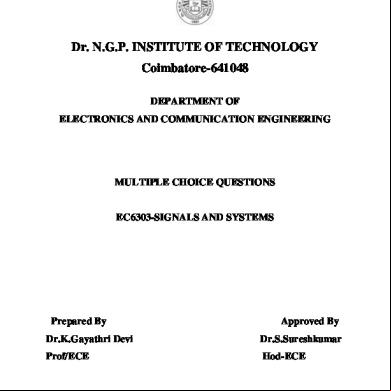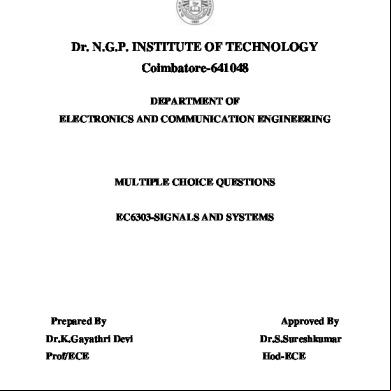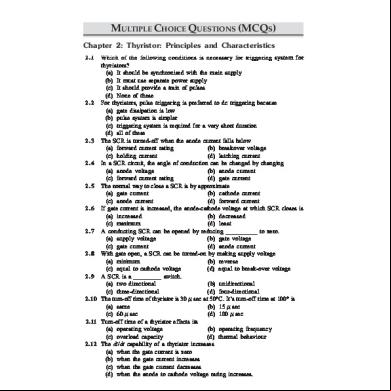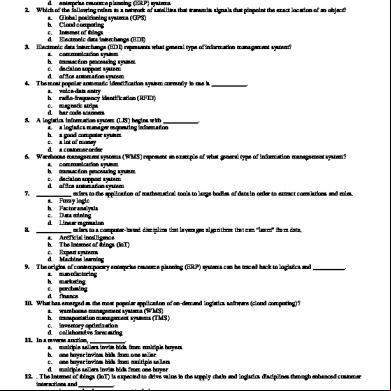Signals And Systems Multiple Choice Questions 23291r
This document was ed by and they confirmed that they have the permission to share it. If you are author or own the copyright of this book, please report to us by using this report form. Report 2z6p3t
Overview 5o1f4z
& View Signals And Systems Multiple Choice Questions as PDF for free.
More details 6z3438
- Words: 1,547
- Pages: 7
Dr.N.G.P. Institute of Technology / Electronics And Communication Engineering
Dr. N.G.P. INSTITUTE OF TECHNOLOGY Coimbatore-641048 DEPARTMENT OF ELECTRONICS AND COMMUNICATION ENGINEERING
MULTIPLE CHOICE QUESTIONS
EC6303-SIGNALS AND SYSTEMS
Prepared By
Approved By
Dr.K.Gayathri Devi
Dr.S.Sureshkumar
Prof/ECE
Hod-ECE
EC6303/ Signals and Systems
Dr.N.G.P. Institute of Technology / Electronics And Communication Engineering Syllabus EC6303
SIGNALS AND SYSTEMS
LTPC 3 1 04
OBJECTIVES: To understand the basic properties of signal & systems and the various methods of classification To learn Laplace Transform &Fourier transform and their properties To know Z transform & DTFT and their properties To characterize LTI systems in the Time domain and various Transform domains UNIT I - CLASSIFICATION OF SIGNALS AND SYSTEMS
9
Continuous time signals (CT signals) - Discrete time signals (DT signals) - Step, Ramp, Pulse, Impulse, Sinusoidal, Exponential, Classification of CT and DT signals - Periodic & Aperiodic signals, Deterministic & Random signals, Energy & Power signals - CT systems and DT systems- Classification of systems – Static & Dynamic, Linear & Nonlinear, Time-variant & Time-invariant, Causal &Non causal, Stable & Unstable. UNIT II- ANALYSIS OF CONTINUOUS TIME SIGNALS
9
Fourier series analysis-spectrum of Continuous Time (CT) signals- Fourier and Laplace Transforms in CT Signal Analysis - Properties. UNIT III- LINEAR TIME INVARIANT- CONTINUOUS TIME SYSTEMS
9
Differential Equation-Block diagram representation-impulse response, convolution integrals-Fourier and Laplace transforms in Analysis of CT systems UNIT IV- ANALYSIS OF DISCRETE TIME SIGNALS
9
Baseband Sampling - DTFT – Properties of DTFT - Z Transform – Properties of Z Transform UNIT V- LINEAR TIME INVARIANT-DISCRETE TIME SYSTEMS
9
Difference Equations-Block diagram representation-Impulse response - Convolution sum- Discrete Fourier and Z Transform Analysis of Recursive & Non-Recursive systems TOTAL (L:45+T:15): 60 PERIODS
OUTCOMES:
EC6303/ Signals and Systems
Dr.N.G.P. Institute of Technology / Electronics And Communication Engineering Upon the completion of the course, students will be able to: o
Analyze the properties of signals & systems
o
Apply Laplace transform, Fourier transform, Z transform and DTFT in signal analysis
o
Analyze continuous time LTI systems using Fourier and Laplace Transforms Analyze discrete time LTI systems using Z transform and DTFT
TEXT BOOK: 1. Allan V.Oppenheim, S.Wilsky and S.H.Nawab, “Signals and Systems”, Pearson, 2007. REFERENCES: 1.
B. P. Lathi, “Principles of Linear Systems and Signals”, Second Edition, Oxford, 2009.
2.
R.E.Zeimer, W.H.Tranter and R.D.Fannin, “Signals & Systems - Continuous and
Discrete”, Pearson, 2007. 3.
John Alan Stuller, “An Introduction to Signals and Systems”, Thomson, 2007.
4.
M.J.Roberts, “Signals & Systems Analysis using Transform Methods & MATLAB”,
Tata McGraw Hill, 2007.
EC6303/ Signals and Systems
Dr.N.G.P. Institute of Technology / Electronics And Communication Engineering QUESTION BANK UNIT-I - CLASSIFICATION OF SIGNALS AND SYSTEMS 1. Which mathematical notation specifies the condition of periodicity for a continuous time signal? a. x(t) = x(t +T0) b. x(n) = x(n+ N) c. x(t) = e-αt d. None of the above ANSWER: (a) 2. Which among the below specified conditions/cases of discrete time in of real constant ‘a’, represents the double-sided decaying exponential signal? a. a > 1 b. 0 < a < 1 c. a < -1 d. -1 < a < 0 ANSWER: (d) 3.
An amplitude of sinc function that es through zero at multiple values of an independent variable ‘x’ ______ a. Decreases with an increase in the magnitude of an independent variable (x) b. Increases with an increase in the magnitude of an independent variable (x) c. Always remains constant irrespective of variation in magnitude of ‘x’ d. Cannot be defined ANSWER: (a)
4. A system is said to be shift invariant only if______ a. shift in the input signal also results in the corresponding shift in the output b. shift in the input signal does not exhibit the corresponding shift in the output c. shifting level does not vary in an input as well as output d. shifting at input does not affect the output
ANSWER: (a)
5. An example of a discrete set of information/system is a. the trajectory of the Sun b. data on a CD c. universe time scale d. movement of water through a pipe
ANSWER: (b)
6. Should real time instruments like oscilloscopes be time invariant? a. Yes b. Sometimes c. Never d. They have no relation with time variance
ANSWER: (b)
7. A system is said to be defined as non causal, when a. the output at the present depends on the input at an earlier time b. the output at the present does not depend on the factor of time at all c. the output at the present depends on the input at the current time d. the output at the present depends on the input at a time instant in the future ANSWER: (d)
EC6303/ Signals and Systems
Dr.N.G.P. Institute of Technology / Electronics And Communication Engineering 8. When we take up design of systems, ideally how do we define the stability of a system? a. A system is stable, if a bounded input gives a bounded output, for some values of the input. b. A system is unstable, if a bounded input gives a bounded output, for all values of the input. c. A system is stable, if a bounded input gives a bounded output, for all values of the input. d. A system is unstable, if a bounded input gives a bounded output, for some values of the input. ANSWER: (c) 9. The discrete time system described by y(n)=x(n 2) is a. Causal, Linear and time invariant. b. Causal, Linear and time variant. c. Non-Causal, Linear and time invariant . d. Non-Causal, Linear and time variant.
ANSWER: (d)
10.The system y(n)=Cos x[n] is a. Static, Linear, time variant. b. Static, Non-Linear, time invariant. c. Dynamic, Non-Linear, time variant. d. Dynamic, Linear, time inVariant.
ANSWER: (b)
UNIT-II - ANALYSIS OF CONTINUOUS TIME SIGNALS 1. The trigonometric fourier series of an even function of time does not have the a. dc term b. cosine term c. sine term d. odd harmonic
ANSWER: (c)
2. Which of the following is an even function of t? a. t2 b. t2 – 4t c. Sin (2t) + 3t d. t3 + 6
ANSWER: (a)
3. For the given periodic function 𝑓 (𝑡) = {
2𝑡 ∶ 0 ≤ 𝑡 ≤ 2 with a period T = 6 . The Fourier coefficient 4 ∶2≤𝑡≤6
a1 a can be computed as a. − 9.2642 b. − 8.1275 c. − 0.9119 d. − 0.5116 4.
ANSWER: (c) 𝟐
The fourier transform of of the signal 𝒙(𝒕) = 𝒆−𝟑𝒕 is of the following form,where A and B are constants a. 𝐴𝑒 −𝐵|𝑓| 2 b. 𝐴𝑒 −𝐵𝑓 c. 𝐴 + 𝐵|𝑓|2 d. 𝐴𝑒 −𝐵𝑓 ANSWER: (b)
EC6303/ Signals and Systems
Dr.N.G.P. Institute of Technology / Electronics And Communication Engineering 5.
The fourier transform for a signal exists when +∞ a. ∫−∞ 𝑓 (𝑡)𝑑𝑡 = ∞
6.
+∞
c.
∫−∞ 𝑓 (𝑡)𝑑𝑡 < ∞ +∞ ∫−∞ |𝑓(𝑡)|𝑑𝑡 = ∞
d.
∫−∞ 𝑓 (𝑡)𝑑𝑡 > ∞
b.
+∞
ANSWER: (b)
The fourier transform for a signal Sin𝝎𝒐 𝒕 is a. 𝑗𝜋[𝛿(𝜔 + 𝜔𝑜 ) − 𝛿(𝜔 − 𝜔𝑜 )] b. 𝜋[𝛿(𝜔 + 𝜔𝑜 ) + 𝛿(𝜔 − 𝜔𝑜 )] c. 𝑗𝜋[𝛿 (𝜔 + 𝜔𝑜 ) + 𝛿(𝜔 − 𝜔𝑜 )] d. 𝜋[𝛿 (𝜔 + 𝜔𝑜 ) − 𝛿(𝜔 − 𝜔𝑜 )]
ANSWER: (a)
7. If 𝑳[𝒇(𝒕)] = 𝑭(𝒔) then 𝑳[𝒇(𝒕 − 𝑻)] is equal to a. 𝑒 𝑠𝑇 𝐹(𝑠) b. 𝑒 −𝑠𝑇 𝐹(𝑠) 𝐹(𝑠) c. 1+𝑒 𝑠𝑇 e.
𝐹(𝑠)
ANSWER: (b)
1−𝑒 −𝑠𝑇
8. The output of a linear system to a unit step input 𝒖(𝒕) is 𝒕𝟐 𝒆−𝟐𝒕 .The system function H(s) is 2 a. 𝑠2 (𝑠+2) b. c. d.
2 (𝑠+2)2 2 (𝑠+2)3 2𝑠 (𝑠+2)3
ANSWER: (d) 9. The transfer function of a zero order hold is 1 a. b. c. d.
𝑠 1−𝑒 −𝑠𝑇 𝑠 𝑒 −𝑠𝑇 𝑠 1−𝑒 𝑠𝑇 𝑠
ANSWER: (b) 10.If 𝜹(𝒕) denotes a unit impulse,then the laplace transform of a. 1 b. s2 c. s d. s-2
𝒅𝟐 𝜹(𝒕) 𝒅𝒕𝟐
will be
ANSWER: (b)
EC6303/ Signals and Systems
Dr.N.G.P. Institute of Technology / Electronics And Communication Engineering UNIT-III - LINEAR TIME INVARIANT CONTINUOUS TIME SIGNALS 1. The step response of the system whose impulse response h(t)=tu(t) is given by a. 𝑡 2 b. c. d.
𝑡2 2 𝑡3
𝑢(𝑡) 𝑢(𝑡)
2 3𝑡 2 2
𝑢(𝑡)
ANSWER: (b)
2. Convolution of x(t+5) with impulse function 𝜹(𝒕 − 𝟕) is equal to a. x(t-12) b. x(t+12) c. x(t-2) d. x(t+2)
ANSWER: (b)
3. If f1(t) and f2(t) are band limited signals such that f1(t) =0 for 1
<3 f1(t) = 0 for 5
<7 =0 elsewhere = 0 elsewhere Then the convolution of f1(t) and f2(t) is zero every where expect for a. 1 < t < 7 b. 3 < t < 5 c. 5 < t < 21 d. 6< t < 10
ANSWER: (d)
4.
5.
A continuous time system is described by four numbers of first order differential equations.The number of integrators present in direct form-II structure a. 2 b. 4 c. 1 d. 8 ANSWER: (b) The homogeneous solution of the differential equation the form a. 𝐶𝑒 𝐴𝑡 b. 𝐶1 + 𝐶2 𝑒 𝐴𝑡 c. 𝑒 𝐴𝑡 d. 𝐶1 + 𝐶2
𝒅𝒚(𝒕) 𝒅𝒕
+ 𝒂𝒚(𝒕) = 𝒙(𝒕); 𝒚(𝟎) = 𝒃, will be of
ANSWER: (a)
EC6303/ Signals and Systems
Dr. N.G.P. INSTITUTE OF TECHNOLOGY Coimbatore-641048 DEPARTMENT OF ELECTRONICS AND COMMUNICATION ENGINEERING
MULTIPLE CHOICE QUESTIONS
EC6303-SIGNALS AND SYSTEMS
Prepared By
Approved By
Dr.K.Gayathri Devi
Dr.S.Sureshkumar
Prof/ECE
Hod-ECE
EC6303/ Signals and Systems
Dr.N.G.P. Institute of Technology / Electronics And Communication Engineering Syllabus EC6303
SIGNALS AND SYSTEMS
LTPC 3 1 04
OBJECTIVES: To understand the basic properties of signal & systems and the various methods of classification To learn Laplace Transform &Fourier transform and their properties To know Z transform & DTFT and their properties To characterize LTI systems in the Time domain and various Transform domains UNIT I - CLASSIFICATION OF SIGNALS AND SYSTEMS
9
Continuous time signals (CT signals) - Discrete time signals (DT signals) - Step, Ramp, Pulse, Impulse, Sinusoidal, Exponential, Classification of CT and DT signals - Periodic & Aperiodic signals, Deterministic & Random signals, Energy & Power signals - CT systems and DT systems- Classification of systems – Static & Dynamic, Linear & Nonlinear, Time-variant & Time-invariant, Causal &Non causal, Stable & Unstable. UNIT II- ANALYSIS OF CONTINUOUS TIME SIGNALS
9
Fourier series analysis-spectrum of Continuous Time (CT) signals- Fourier and Laplace Transforms in CT Signal Analysis - Properties. UNIT III- LINEAR TIME INVARIANT- CONTINUOUS TIME SYSTEMS
9
Differential Equation-Block diagram representation-impulse response, convolution integrals-Fourier and Laplace transforms in Analysis of CT systems UNIT IV- ANALYSIS OF DISCRETE TIME SIGNALS
9
Baseband Sampling - DTFT – Properties of DTFT - Z Transform – Properties of Z Transform UNIT V- LINEAR TIME INVARIANT-DISCRETE TIME SYSTEMS
9
Difference Equations-Block diagram representation-Impulse response - Convolution sum- Discrete Fourier and Z Transform Analysis of Recursive & Non-Recursive systems TOTAL (L:45+T:15): 60 PERIODS
OUTCOMES:
EC6303/ Signals and Systems
Dr.N.G.P. Institute of Technology / Electronics And Communication Engineering Upon the completion of the course, students will be able to: o
Analyze the properties of signals & systems
o
Apply Laplace transform, Fourier transform, Z transform and DTFT in signal analysis
o
Analyze continuous time LTI systems using Fourier and Laplace Transforms Analyze discrete time LTI systems using Z transform and DTFT
TEXT BOOK: 1. Allan V.Oppenheim, S.Wilsky and S.H.Nawab, “Signals and Systems”, Pearson, 2007. REFERENCES: 1.
B. P. Lathi, “Principles of Linear Systems and Signals”, Second Edition, Oxford, 2009.
2.
R.E.Zeimer, W.H.Tranter and R.D.Fannin, “Signals & Systems - Continuous and
Discrete”, Pearson, 2007. 3.
John Alan Stuller, “An Introduction to Signals and Systems”, Thomson, 2007.
4.
M.J.Roberts, “Signals & Systems Analysis using Transform Methods & MATLAB”,
Tata McGraw Hill, 2007.
EC6303/ Signals and Systems
Dr.N.G.P. Institute of Technology / Electronics And Communication Engineering QUESTION BANK UNIT-I - CLASSIFICATION OF SIGNALS AND SYSTEMS 1. Which mathematical notation specifies the condition of periodicity for a continuous time signal? a. x(t) = x(t +T0) b. x(n) = x(n+ N) c. x(t) = e-αt d. None of the above ANSWER: (a) 2. Which among the below specified conditions/cases of discrete time in of real constant ‘a’, represents the double-sided decaying exponential signal? a. a > 1 b. 0 < a < 1 c. a < -1 d. -1 < a < 0 ANSWER: (d) 3.
An amplitude of sinc function that es through zero at multiple values of an independent variable ‘x’ ______ a. Decreases with an increase in the magnitude of an independent variable (x) b. Increases with an increase in the magnitude of an independent variable (x) c. Always remains constant irrespective of variation in magnitude of ‘x’ d. Cannot be defined ANSWER: (a)
4. A system is said to be shift invariant only if______ a. shift in the input signal also results in the corresponding shift in the output b. shift in the input signal does not exhibit the corresponding shift in the output c. shifting level does not vary in an input as well as output d. shifting at input does not affect the output
ANSWER: (a)
5. An example of a discrete set of information/system is a. the trajectory of the Sun b. data on a CD c. universe time scale d. movement of water through a pipe
ANSWER: (b)
6. Should real time instruments like oscilloscopes be time invariant? a. Yes b. Sometimes c. Never d. They have no relation with time variance
ANSWER: (b)
7. A system is said to be defined as non causal, when a. the output at the present depends on the input at an earlier time b. the output at the present does not depend on the factor of time at all c. the output at the present depends on the input at the current time d. the output at the present depends on the input at a time instant in the future ANSWER: (d)
EC6303/ Signals and Systems
Dr.N.G.P. Institute of Technology / Electronics And Communication Engineering 8. When we take up design of systems, ideally how do we define the stability of a system? a. A system is stable, if a bounded input gives a bounded output, for some values of the input. b. A system is unstable, if a bounded input gives a bounded output, for all values of the input. c. A system is stable, if a bounded input gives a bounded output, for all values of the input. d. A system is unstable, if a bounded input gives a bounded output, for some values of the input. ANSWER: (c) 9. The discrete time system described by y(n)=x(n 2) is a. Causal, Linear and time invariant. b. Causal, Linear and time variant. c. Non-Causal, Linear and time invariant . d. Non-Causal, Linear and time variant.
ANSWER: (d)
10.The system y(n)=Cos x[n] is a. Static, Linear, time variant. b. Static, Non-Linear, time invariant. c. Dynamic, Non-Linear, time variant. d. Dynamic, Linear, time inVariant.
ANSWER: (b)
UNIT-II - ANALYSIS OF CONTINUOUS TIME SIGNALS 1. The trigonometric fourier series of an even function of time does not have the a. dc term b. cosine term c. sine term d. odd harmonic
ANSWER: (c)
2. Which of the following is an even function of t? a. t2 b. t2 – 4t c. Sin (2t) + 3t d. t3 + 6
ANSWER: (a)
3. For the given periodic function 𝑓 (𝑡) = {
2𝑡 ∶ 0 ≤ 𝑡 ≤ 2 with a period T = 6 . The Fourier coefficient 4 ∶2≤𝑡≤6
a1 a can be computed as a. − 9.2642 b. − 8.1275 c. − 0.9119 d. − 0.5116 4.
ANSWER: (c) 𝟐
The fourier transform of of the signal 𝒙(𝒕) = 𝒆−𝟑𝒕 is of the following form,where A and B are constants a. 𝐴𝑒 −𝐵|𝑓| 2 b. 𝐴𝑒 −𝐵𝑓 c. 𝐴 + 𝐵|𝑓|2 d. 𝐴𝑒 −𝐵𝑓 ANSWER: (b)
EC6303/ Signals and Systems
Dr.N.G.P. Institute of Technology / Electronics And Communication Engineering 5.
The fourier transform for a signal exists when +∞ a. ∫−∞ 𝑓 (𝑡)𝑑𝑡 = ∞
6.
+∞
c.
∫−∞ 𝑓 (𝑡)𝑑𝑡 < ∞ +∞ ∫−∞ |𝑓(𝑡)|𝑑𝑡 = ∞
d.
∫−∞ 𝑓 (𝑡)𝑑𝑡 > ∞
b.
+∞
ANSWER: (b)
The fourier transform for a signal Sin𝝎𝒐 𝒕 is a. 𝑗𝜋[𝛿(𝜔 + 𝜔𝑜 ) − 𝛿(𝜔 − 𝜔𝑜 )] b. 𝜋[𝛿(𝜔 + 𝜔𝑜 ) + 𝛿(𝜔 − 𝜔𝑜 )] c. 𝑗𝜋[𝛿 (𝜔 + 𝜔𝑜 ) + 𝛿(𝜔 − 𝜔𝑜 )] d. 𝜋[𝛿 (𝜔 + 𝜔𝑜 ) − 𝛿(𝜔 − 𝜔𝑜 )]
ANSWER: (a)
7. If 𝑳[𝒇(𝒕)] = 𝑭(𝒔) then 𝑳[𝒇(𝒕 − 𝑻)] is equal to a. 𝑒 𝑠𝑇 𝐹(𝑠) b. 𝑒 −𝑠𝑇 𝐹(𝑠) 𝐹(𝑠) c. 1+𝑒 𝑠𝑇 e.
𝐹(𝑠)
ANSWER: (b)
1−𝑒 −𝑠𝑇
8. The output of a linear system to a unit step input 𝒖(𝒕) is 𝒕𝟐 𝒆−𝟐𝒕 .The system function H(s) is 2 a. 𝑠2 (𝑠+2) b. c. d.
2 (𝑠+2)2 2 (𝑠+2)3 2𝑠 (𝑠+2)3
ANSWER: (d) 9. The transfer function of a zero order hold is 1 a. b. c. d.
𝑠 1−𝑒 −𝑠𝑇 𝑠 𝑒 −𝑠𝑇 𝑠 1−𝑒 𝑠𝑇 𝑠
ANSWER: (b) 10.If 𝜹(𝒕) denotes a unit impulse,then the laplace transform of a. 1 b. s2 c. s d. s-2
𝒅𝟐 𝜹(𝒕) 𝒅𝒕𝟐
will be
ANSWER: (b)
EC6303/ Signals and Systems
Dr.N.G.P. Institute of Technology / Electronics And Communication Engineering UNIT-III - LINEAR TIME INVARIANT CONTINUOUS TIME SIGNALS 1. The step response of the system whose impulse response h(t)=tu(t) is given by a. 𝑡 2 b. c. d.
𝑡2 2 𝑡3
𝑢(𝑡) 𝑢(𝑡)
2 3𝑡 2 2
𝑢(𝑡)
ANSWER: (b)
2. Convolution of x(t+5) with impulse function 𝜹(𝒕 − 𝟕) is equal to a. x(t-12) b. x(t+12) c. x(t-2) d. x(t+2)
ANSWER: (b)
3. If f1(t) and f2(t) are band limited signals such that f1(t) =0 for 1
ANSWER: (d)
4.
5.
A continuous time system is described by four numbers of first order differential equations.The number of integrators present in direct form-II structure a. 2 b. 4 c. 1 d. 8 ANSWER: (b) The homogeneous solution of the differential equation the form a. 𝐶𝑒 𝐴𝑡 b. 𝐶1 + 𝐶2 𝑒 𝐴𝑡 c. 𝑒 𝐴𝑡 d. 𝐶1 + 𝐶2
𝒅𝒚(𝒕) 𝒅𝒕
+ 𝒂𝒚(𝒕) = 𝒙(𝒕); 𝒚(𝟎) = 𝒃, will be of
ANSWER: (a)
EC6303/ Signals and Systems










